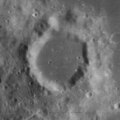Biot (crater)
 Photo by Lunar Reconnaissance Orbiter | |
| Coordinates | 22°42′S 51°06′E / 22.7°S 51.1°ECoordinates: 22°42′S 51°06′E / 22.7°S 51.1°E |
|---|---|
| Diameter | 13 km |
| Depth | 1.5 km |
| Colongitude | 309° at sunrise |
| Eponym | Jean-Baptiste Biot |
Biot is a small, bowl-shaped lunar impact crater located in the southern reaches of the Mare Fecunditatis. It is named after French astronomer Jean-Baptiste Biot."Biot (crater)". Gazetteer of Planetary Nomenclature. USGS Astrogeology Research Program. It is a circular formation with a sharp-edged rim that has not been significantly worn. The inner walls slope down to a relatively small interior floor. The albedo of the wide inner walls is higher than the surrounding lunar mare, giving it a light hue. To the southeast is the crater Wrottesley.
Satellite craters[]
By convention, these features are identified on lunar maps by placing the letter on the side of the crater midpoint that is closest to Biot.
| Biot | Latitude | Longitude | Diameter |
|---|---|---|---|
| A | 22.2° S | 48.9° E | 15 km |
| B | 20.4° S | 49.6° E | 28 km |
| C | 22.0° S | 51.1° E | 8 km |
| D | 24.3° S | 50.3° E | 9 km |
| E | 24.6° S | 50.9° E | 8 km |
| T | 21.4° S | 49.9° E | 5 km |

Biot B crater
References[]
- Andersson, L. E.; Whitaker, E. A. (1982). NASA Catalogue of Lunar Nomenclature. NASA RP-1097.
- Bussey, B.; Spudis, P. (2004). The Clementine Atlas of the Moon. New York: Cambridge University Press. ISBN 978-0-521-81528-4.
- Cocks, Elijah E.; Cocks, Josiah C. (1995). Who's Who on the Moon: A Biographical Dictionary of Lunar Nomenclature. Tudor Publishers. ISBN 978-0-936389-27-1.
- McDowell, Jonathan (July 15, 2007). "Lunar Nomenclature". Jonathan's Space Report. Retrieved 2007-10-24.
- Menzel, D. H.; Minnaert, M.; Levin, B.; Dollfus, A.; Bell, B. (1971). "Report on Lunar Nomenclature by the Working Group of Commission 17 of the IAU". Space Science Reviews. 12 (2): 136–186. Bibcode:1971SSRv...12..136M. doi:10.1007/BF00171763. S2CID 122125855.
- Moore, Patrick (2001). On the Moon. Sterling Publishing Co. ISBN 978-0-304-35469-6.
- Price, Fred W. (1988). The Moon Observer's Handbook. Cambridge University Press. ISBN 978-0-521-33500-3.
- Rükl, Antonín (1990). Atlas of the Moon. Kalmbach Books. ISBN 978-0-913135-17-4.
- Webb, Rev. T. W. (1962). Celestial Objects for Common Telescopes (6th revised ed.). Dover. ISBN 978-0-486-20917-3.
- Whitaker, Ewen A. (1999). Mapping and Naming the Moon. Cambridge University Press. ISBN 978-0-521-62248-6.
- Wlasuk, Peter T. (2000). Observing the Moon. Springer. ISBN 978-1-85233-193-1.
- Kumar, Ajeet; Kochar, Inderkumar M.; Pandey, Dharmendra K.; Das, Anup; Putrevu, Deepak; Kumar, Raj; Panigrahi, Rajib K. (2021). "Dielectric Constant Estimation of Lunar Surface Using Mini-RF and Chandrayaan-2 SAR Data". IEEE Transactions on Geoscience and Remote Sensing. XX (X): 1–8. doi:10.1109/TGRS.2021.3103383.
External links[]
 Media related to Biot (crater) at Wikimedia Commons
Media related to Biot (crater) at Wikimedia Commons
Categories:
- LQ21 quadrangle
- Impact craters on the Moon


